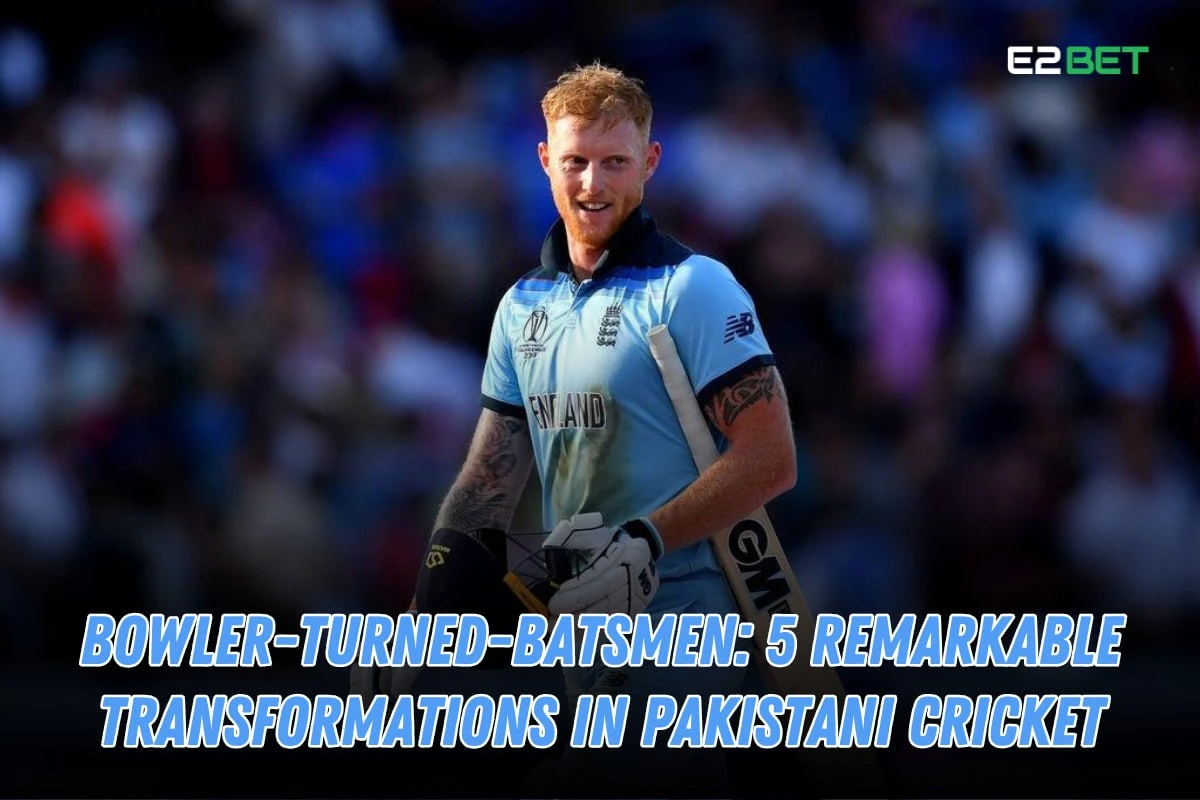Pakistan has always been a land of cricketing marvels. The country has produced legends in every department, from fiery pacers to elegant batsmen. Bowler-Turned-Batsmen Pakistan, But what makes cricket even more thrilling is witnessing players adapt and excel in roles beyond their primary skills. In Pakistani cricket, several bowler-turned-batsmen have defied expectations, transforming into formidable batsmen. Let’s dive into Pakistan’s cricket history’s top 5 remarkable transformations.

Importance of Adaptability in Cricket
Cricket is no longer a game of specialists. In today’s competitive landscape, players who can contribute in multiple roles are invaluable. This adaptability often becomes a turning point in a player’s career, making them indispensable to the team. From Wasim Akram’s batting contributions to Shahid Afridi’s batting evolution, adaptability has been the cornerstone of their success.
Top 5 Remarkable Bowler-Turned-Batsmen in Pakistani Cricket
#1: Wasim Akram – The Sultan of Swing to Power Hitter
Known as one of the greatest fast bowlers, Wasim Akram was also a handy batsman. His memorable innings in the 1999 World Cup and countless lower-order cameos proved his mettle with the bat. His ability to hit sixes under pressure made him a crowd favorite. Akram’s batting stats reveal his contribution to Pakistan’s cricket legacy.
#2: Shahid Afridi – From Leg Spin to Boom Boom Hitter
Shahid Afridi started his career as a leg-spinner but quickly gained fame for his explosive batting. His 37-ball century against Sri Lanka remains iconic. Afridi’s transformation into a fearsome all-rounder epitomized his nickname, “Boom Boom.” His career highlights continue to inspire aspiring all-rounders in Pakistan.
#3: Abdul Razzaq – The Finisher
Abdul Razzaq began as a medium pacer but evolved into one of the finest finishers in ODI cricket. His match-winning century against South Africa in 2010 showcased his ability to turn games single-handedly. Razzaq’s best batting moments remain etched in the minds of cricket fans.
#4: Mohammad Hafeez – The Professor’s Dual Role
Initially known for his off-spin, Mohammad Hafeez worked tirelessly to cement his spot as a top-order batsman. His versatility as a dependable batsman and occasional bowler earned him the title of “The Professor.” Hafeez’s career timeline exemplifies his dual-role capabilities.
#5: Shoaib Malik – From Part-Time Bowler to Batting Mainstay
Shoaib Malik started as a part-time spinner but became a reliable middle-order batsman. His adaptability and experience made him one of Pakistan’s most consistent performers across formats. Malik’s cricket profile highlights his batting milestones and leadership skills.
Factors Driving These Transformations
So, what triggers these remarkable shifts? A mix of necessity, coaching, and personal determination often fuels such changes. Players adapt to fill gaps in the team, creating opportunities to reinvent themselves. The role transitions in cricket demonstrate the importance of staying versatile.
The Role of Domestic and League Cricket
Pakistan’s domestic circuit and leagues like the Pakistan Super League (PSL) have provided a platform for players to experiment and refine their skills. PSL live streaming showcases the potential of emerging players developing dual roles under high-pressure situations.
Comparing Transformations Across Cricket Nations
While other nations boast similar stories, Pakistan stands out for producing a significant number of dual-role players. This trend reflects the country’s cricketing culture, where improvisation often takes precedence. Inspirational cricketers in Pakistan have set benchmarks for adaptability.
Notable Mentions
Players like Imad Wasim and Shadab Khan deserve mention for their contributions in both batting and bowling. These modern cricketers continue the legacy of bowler-to-batsman journeys in Pakistan.
Challenges Faced During Transition
Switching roles is no easy feat. Players must overcome technical barriers, adjust their mindset, and deal with heightened expectations. Despite these hurdles, these players thrived under pressure, showcasing their versatility.
The Impact of Coaching and Training
Behind every successful transformation is a coach who believes in the player’s potential. Modern-day training techniques and facilities have also played a crucial role in developing multi-skilled players. Coaching academies in Pakistan are instrumental in fostering such talent.
Lessons for Aspiring Cricketers
These stories are a source of inspiration for young players. They highlight the importance of hard work, adaptability, and the willingness to embrace new challenges. Success stories in Pakistan cricket often revolve around resilience and transformation.
How These Transformations Benefitted Pakistan Cricket
Having players who excel in multiple roles has strengthened Pakistan’s team balance. From memorable victories to thrilling finishes, these transformations have elevated the team’s performance on the global stage. Pakistan’s cricket legacy owes much to its versatile players.
The Evolution of All-Rounders in Modern Cricket
Modern cricket increasingly values all-rounders who can contribute to every facet of the game. This shift has further encouraged players to explore dual roles. The evolution of all-rounders underscores the growing emphasis on adaptability.
Future Prospects
With emerging talents like Agha Salman and Shadab Khan, Pakistan cricket looks poised to produce more versatile players. These young stars might soon carve their names into history. Domestic cricket’s impact on careers remains vital for such transitions.
Impact on Pakistan’s Cricket Legacy
The journey of bowlers-turned-batsmen has enriched Pakistan’s cricketing heritage. Their stories of perseverance and skill continue to inspire fans and players alike. Famous Pakistani all-rounders have left a lasting legacy.
Conclusion
The top 5 bowler-turned-batsmen in Pakistani cricket exemplify the spirit of adaptability and resilience. Their transformations not only enhanced their careers but also left a lasting impact on Pakistan’s cricketing journey.
FAQs
Q1. Who is the most successful bowler-turned-batsman in Pakistan?
Ans: Shahid Afridi tops the list with his explosive batting and leg-spin combination.
Q2. How did Shahid Afridi transform into a powerful hitter?
Ans: Afridi’s fearless approach and natural talent helped him dominate bowlers worldwide.
Q3. What role does PSL play in developing dual-role players?
Ans: PSL provides a platform for players to experiment and develop their skills in high-pressure situations.
Q4. Are there any current bowlers likely to become batsmen?
Ans: Players like Shadab Khan and Faheem Ashraf show potential for significant batting contributions.
Q5. Why is versatility crucial in modern cricket?
Ans: Versatile players offer flexibility in team combinations and are valuable assets in all formats.